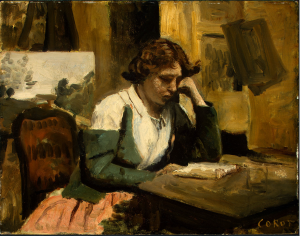

The Gleaners is one of Millet’s best known works, and we can tell it’s a Realist painting because there is a wonderful photograph from the 1800s which shows us a similar scene.
True to one of his favourite subjects – peasant life – this painting is the culmination of ten years of research on the theme of the gleaners. These women represent the rural working-class.
They were authorised to go quickly through the fields at sunset to pick up, one by one, the ears of corn missed by the harvesters.
Millet shows three women in the foreground, bent double, their eyes raking the ground. He demonstrates the three phases of the back-breaking repetitive movement imposed by this thankless task: bending over, picking up the ears of corn and straightening up again. We can see the sweeping movement of the action by the way in which the women are positioned.
Their austerity contrasts with the abundant harvest in the distance: haystacks, sheaves of wheat, a cart and a busy crowd of harvesters. The festive, brightly lit bustle is further distanced by the abrupt change of scale.
The slanting light of the setting sun accentuates the volumes in the foreground and gives the gleaners a sculptural look. It picks out their hands, necks, shoulders and backs and brightens the colours of their clothing. You can tell that these are work-roughened hands, and almost feel the aches in their backs from stooping.
Then Millet slowly smudges the distance into a powdery golden haze, accentuating the countryside in the background.
The man on horseback, isolated on the right (not easily seen), is probably a steward. In charge of supervising the work on the estate, he also makes sure that the gleaners respect the rules governing their task. His presence adds social distance by bringing a reminder of the landlords he represents.
There is a very limited palette in this painting. Note the use of graduated tones, with the use of blue and red in the caps of the women on the left to give them individuality, even though we can’t see their faces. Our eye is also drawn through the centre of the work by the light in the woman’s shoulder through to the background. However, they dominate the scene and their presence is powerful, even though in reality this was not the case.
Using simple pictorial composition, Millet gives these certainly poor but no less dignified gleaners recognition for the way in which they lived.
This is an excerpt from my online modern art appreciation program http://www.modernartappreciation.com
